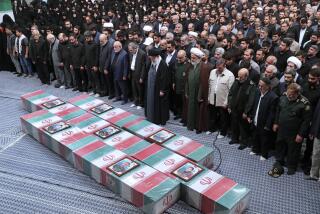Could Iran — and Hezbollah — strike in Latin America?

After then-candidate Jair Bolsonaro was stabbed at a Brazilian presidential campaign rally in 2018, some of his allies advanced a perplexing theory.
Despite widespread evidence that a Brazilian man with a history of mental health problems had carried out the attack alone, they suggested it had actually been planned by Hezbollah, the Lebanese political party and militant organization that serves as a proxy for Iran and which the U.S. regards as a terrorist group.
Pundits and politicians in the U.S., particularly those on the far right, have long issued periodic warnings that Hezbollah and other Islamic groups pose a serious threat in Latin America.
Those ideas have gained more currency in the region in recent years, as the Trump administration pushes its allies there to also designate Hezbollah as a terrorist group. Three countries — Argentina, Paraguay and Honduras — have done so in recent months.
Though the Shiite Muslim organization was clearly a threat in the 1990s, the picture in recent years has been blurrier, with the group often seeming to function as a bogeyman of sorts, as it did after the Bolsonaro stabbing.
The task of assessing the current danger took on new urgency this week as Iran vowed retaliation for the U.S. killing of Iranian military commander Gen. Qassem Suleimani.
“I would not be surprised if an attack occurs in Latin America,” said Emanuele Ottolenghi, a fellow with the Foundation for the Defense of Democracies, a think tank in Washington known for its hawkish stance on Iran. “The threat level has clearly gone up.”
Some experts argue that such warnings are overblown. They say Hezbollah has no organized structure in South America and likely doesn’t have the capacity to launch major attacks. It may engage in small-time drug-smuggling or money laundering in the region, but many people who have been accused of such activities appear to be run-of-the-mill criminals suspected of ties to terrorism simply because of their Middle Eastern descent.
“Hezbollah on a really, really small scale may use this area to launder money,” said Fernando Brancoli, a professor of international security at the Federal University of Rio de Janeiro. “But the threat is exaggerated.”
He and others said the U.S. has pushed the narrative that Hezbollah is a menace to help justify its war on terror and that Latin American governments that have begun to embrace it do so because they hope to gain from increased cooperation with the U.S. and other countries.
The Trump administration, for example, has proposed that Israel provide counterterrorism military training to Latin American nations to help them fight Hezbollah, which several countries have said they would accept.
After largely ignoring Latin American diplomacy during Trump’s first year in office, the administration has recently been much more active in the region as it cultivates partners against what it sees as a growing threat.
“The roots of these terror groups may be many miles away, but their branches twist around the globe, raising funds, seeking recruits, probing for our weaknesses and challenging our defenses,” Secretary of State Mike Pompeo said at a U.S.-organized counter terrorism conference in Argentina last summer.
Fears about Hezbollah are grounded in history. With backing from Iran, the group is widely believed to have carried out two deadly bombings in Argentina in the 1990s that targeted a Jewish community center and Israeli Embassy. The attacks killed more than 100 people and injured hundreds more.
The U.S. government says it is worried about Hezbollah’s ties to the anti-American regime in Venezuela and accuses the group of using Latin America as a fundraising base, particularly in the notoriously lawless region where Argentina, Brazil and Paraguay meet.
“Hezbollah continues to have our hemisphere squarely in its sights today,” Nathan Sales, a top State Department official, told a gathering of the American Jewish Committee last month.
He pointed to Assad Ahmad Barakat, whom the U.S. alleges is a Hezbollah financier and who currently faces criminal charges in Paraguay, and Mohammed Hamdar, an alleged Hezbollah member who was arrested in 2014 and is on trial in Peru on terrorism charges.
Some experts have expressed doubts about those charges and other cases, pointing out that Hezbollah is a major political party in very small country, and that many Lebanese migrants are likely to have loose ties to the group.
“We have to define ‘connections’ to Hezbollah,” Brancoli said.
Arabs from Lebanon, Syria and Egypt — most of them Christian — first began migrating to South America in the 1920s after the collapse of the Ottoman Empire.
A second, smaller migration was more dominated by Muslims from those regions during the Lebanese civil war, which started in 1975 and continued throughout the 1980s, just as Hezbollah was being established.
As’ad AbuKhalil, a professor of political science at Cal State Stanislaus, said U.S. officials have long exaggerated connections between Latin America and the Middle East, such as when they warned in the 1980s that the Palestine Liberation Organization was using its links to leftist political regimes in the region to fund insurgent campaigns back home.
More recently, Trump administration officials alleged that members of the Islamic State had infiltrated a caravan of Central American migrants trekking to the U.S. border — a claim quickly debunked by journalists on the ground.
“I have yet to see any evidence of these nefarious connections,” said AbuKhalil.
More to Read
Start your day right
Sign up for Essential California for news, features and recommendations from the L.A. Times and beyond in your inbox six days a week.
You may occasionally receive promotional content from the Los Angeles Times.







